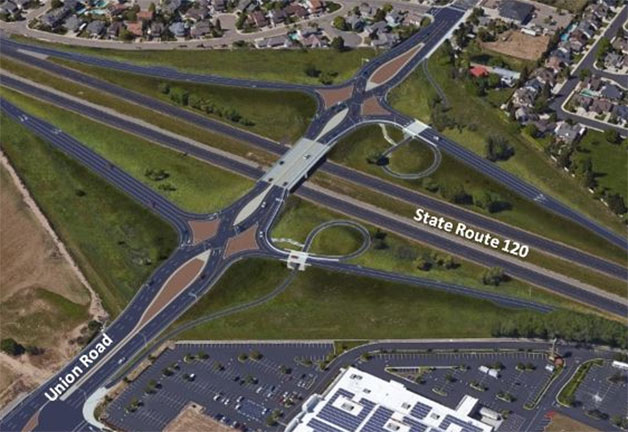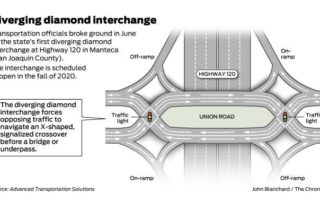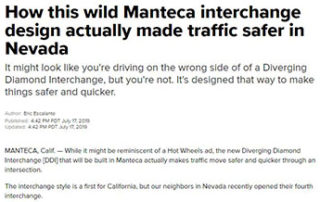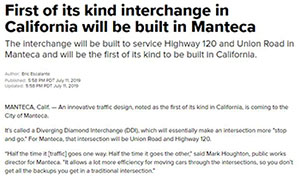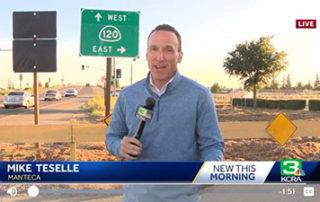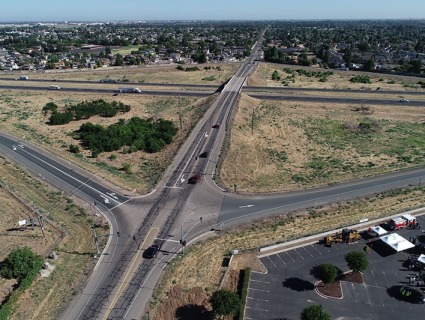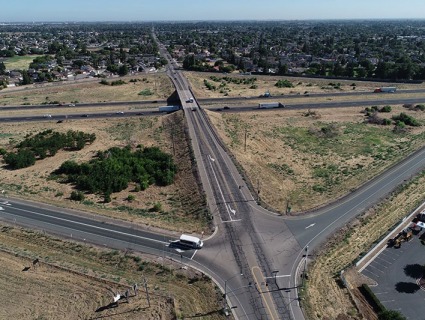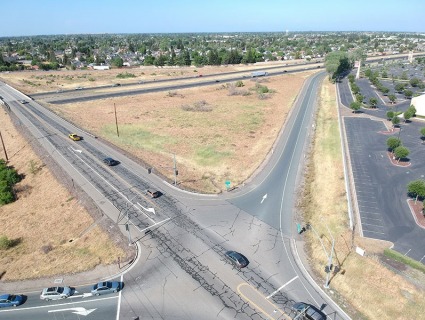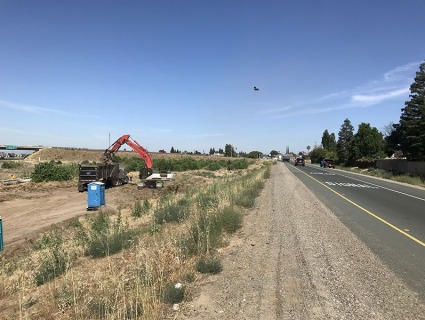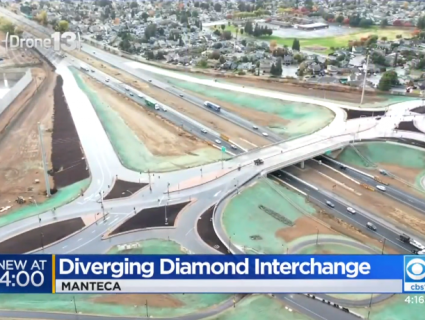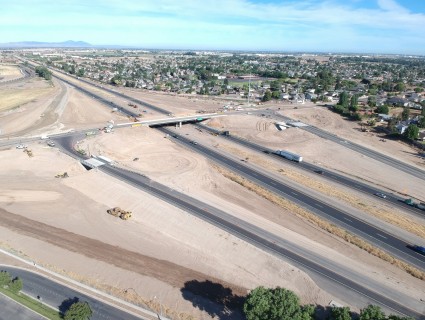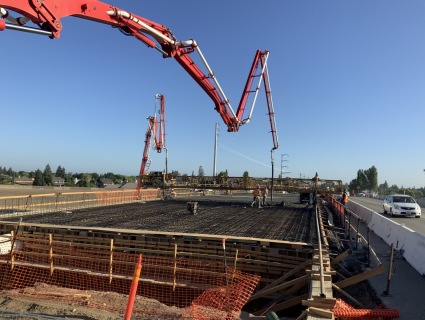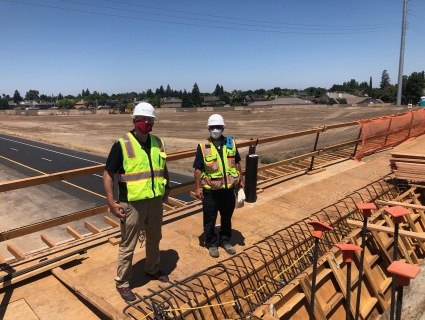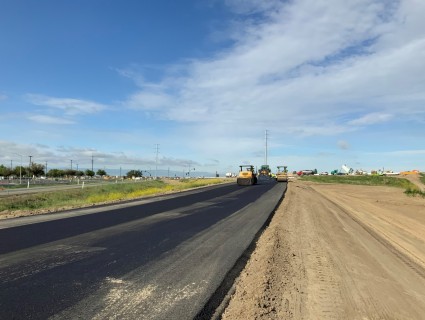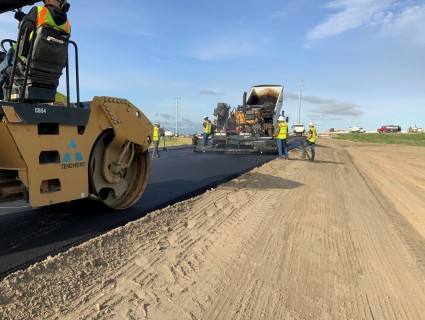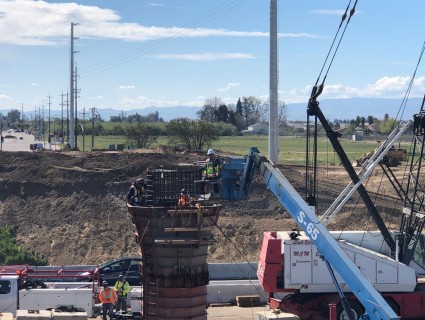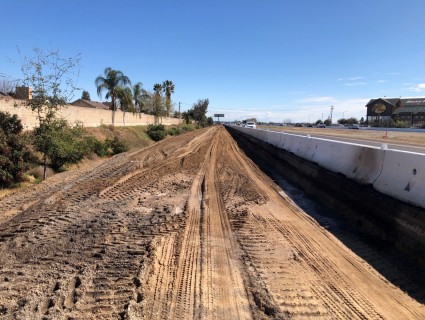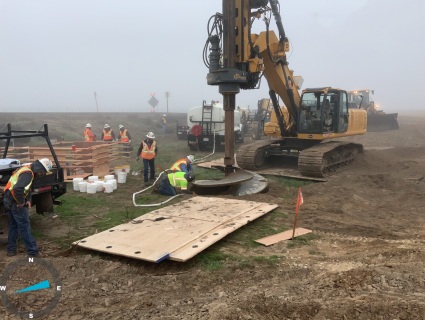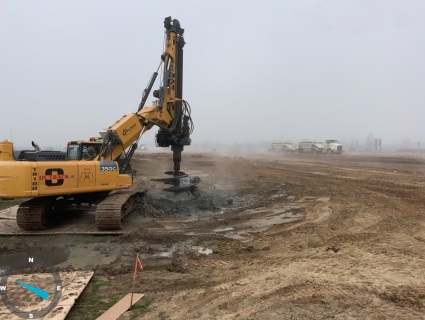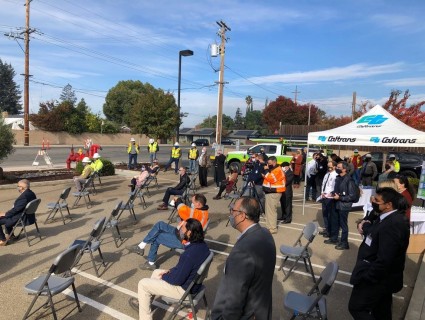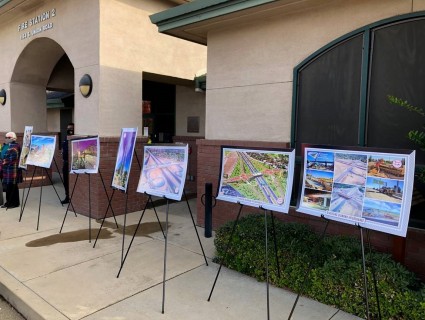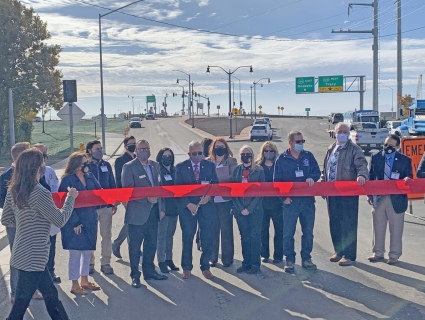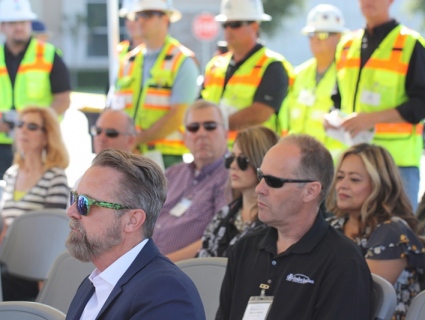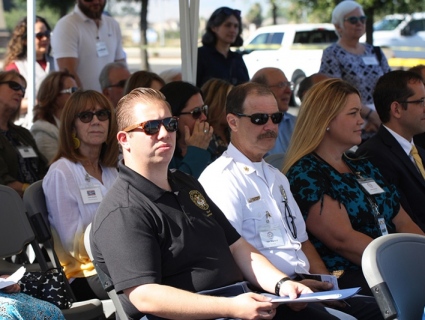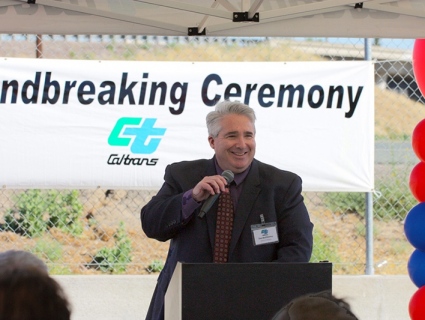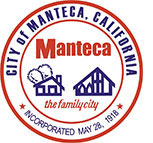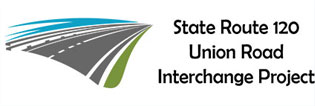Project
Description
SR120/Union Road Interchange Project
1st Diverging Diamond Interchange (DDI) in California.
1st Diverging Diamond Interchange (DDI) in California.
The City of Manteca in partnership with Caltrans District 10 and SJCOG are working to improve safety and traffic flow at interchange located at State Route 120 and Union Road. The project will improve safety conditions by constructing new on and off ramps, widening Union Road to 4 lanes between Daniels Street and Lifestyle Street, and providing a Class I shared-use path and Class II bike lanes.
The new interchange reduces conflict points between vehicles and moves traffic more efficiently through the interchange. The DDI is unique in that traffic on the local road is shifted to the left side of the road, before being shifted back to the right. Eliminating any left hand turns through the intersection. Upgrading to the unique DDI configuration provides significant cost savings and safety benefits for both vehicles and pedestrians.
Union Road is a key crossing of State Route 120 in the City’s bicycle master plan. The new Class I path will provide a 10-foot wide grade-separated trail that eliminates all bicycle/vehicle conflict points within the interchange to provide safe and efficient passage for bicycles, pedestrians, and other non-motorized travel.
Auxiliary lanes will be constructed between Airport Way and Main Street on eastbound and westbound State Route 120 to provide for increased traffic flow during peak times.
Benefits of a
Diverging Diamond Interchange (DDI)
Diverging Diamond Interchange (DDI)
Safety is a priority. This Diverging Diamond Interchange will reduce the number of conflict points from the existing 26 down to 14. Most importantly, the more severe collision types (crossing/T-bone) are reduced form 10 down to two.
Existing overpass does not have designated pedestrian or bicycle access. The new interchange will provide a Class I shared-use path and Class II bike lanes. The new Class I path will provide a 10-foot wide grade-separated trail that eliminates all bicycle/vehicle conflict points within the interchange providing safe and efficient passage for bicycles, pedestrians, and other non-motorized travel.
Cost effective solution allows for the project costs to be greatly reduced compared to other interchange types. Also allows for the existing bridge to remain.
Improved traffic operations on Union Road. This project will construct auxiliary lanes on State Route 120 from Airport Way to Main Street.
Compact footprint by eliminating right of way acquisition.
Class I grade separated shared use path improves pedestrian and bicycle mobility. This accomplishes the City’s General Plan goal and closes a significant gap in the pedestrian network.
Safety is highly increased with a DDI due to a reduction in collision points from 26 to 14 and separate bicycles and pedestrian lanes.
Construction
Schedule
Project Schedule
| June 25, 2019 | Groundbreaking Event |
| July 2019 | Construction Begins |
| November 25, 2020 | New DDI opens |
Project Notes
- Delays are anticipated weekdays between 6:00am – 4:00pm on Union Road between Atherton Drive and Daniels Street. Please be aware of increased truck traffic in the area as a result of the interchange improvements.
- Traffic Detours and Closures will be posted in advance on this website in the Updates Section and the City of Manteca Facebook Page.
- Work will generally take place between 6 a.m. and 5 p.m. Monday through Friday. Night and/or weekend work may occur as necessary.
Project Hotline: 209.707.3470
Project
Updates
Four New Pedestrian Bridges at SR120/Union Road Interchange
The City of Manteca is excited to announce the beginning construction of four new pedestrian bridges at SR120/Union Road Interchange. Beginning in October 2019 you will see construction crews working on what will become pedestrian bridges. These bridges will eventually provide safe access to pedestrians and bicycles crossing State Route 120. No road closures or detours are expected. However, you will see cranes and other large equipment during this time. You may also experience some increased noise during daytime hours from pile driving operation.
To receive project updates, please visit www.mantecaddi.net and go to the Keep Up-To-Date on Project Details section of the website where you can sign up for email updates. If you have any questions or concerns please send us an email from the website or call us on the 24-hour hotline at 209.707.3470.
Prepare to be perplexed: New diverging diamond interchanges coming to California
A new kind of freeway interchange is coming to California — possibly to Berkeley, in time — and it’s likely to make drivers scratch their heads in confusion.
It’s called a diverging diamond. To enter the freeway, the cutting-edge interchange requires drivers to veer at a 45-degree angle across the center divide, switching sides with opposing traffic and briefly motoring across as if they are in England.
By being on the left side, they can then glide left onto the highway without a dangerous 90-degree turn across oncoming cars.

Transportation officials broke ground on the state’s first diverging diamond interchange late last month where Union Road crosses Highway 120 in Manteca (San Joaquin County). The interchange is not scheduled to open until fall 2020, but the design’s popularity is spreading.
At least two more diverging diamonds are planned in the Central Valley, and engineers are considering the design for the reconstruction of the Ashby Avenue interchange over busy Interstate 80 in Berkeley.
Some traffic planners are smitten with the concept and how, in the name of efficiency and safety, it forces opposing traffic to negotiate an X-shaped, signalized crossover before a bridge or underpass. As freeway-bound drivers drift to the left to an on-ramp, those heading through the interchange to the other side of the freeway follow the road back to the right at another crossover.
Source: July 19, 2019, Michael Cabanatuan, San Francisco Chronicle
“Prepare to be perplexed: New diverging diamond interchanges coming to California”
https://www.sfchronicle.com/bayarea/article/Prepare-to-be-perplexed-New-diverging-14106699.php
How this wild Manteca interchange design actually made traffic safer in Nevada
It might look like you’re driving on the wrong side of of a Diverging Diamond Interchange, but you’re not. It’s designed that way to make things safer and quicker.
MANTECA, Calif. — While it might be reminiscent of a Hot Wheels ad, the new Diverging Diamond Interchange [DDI] that will be built in Manteca actually makes traffic move safer and quicker through an intersection.
The interchange style is a first for California, but our neighbors in Nevada recently opened their fourth interchange.
“It can be a little bit of a shock to some people because I think the famous quote that people like to use is ‘It’s like you’re driving on the wrong side of the road,’ but you’re not. It’s designed that way,” said Devin Cartwright, Project Manager with the Nevada Department of Transportation.
While the interchange has caused concerns for some in California, Cartwright heard a lot of the same concerns when he designed Nevada’s first DDI in 2013. Despite the concern, the end result was a drop in both the number of crashes and a drop in the severity of the crashes.
How a DDI works
A DDI has drivers enter from the right side of the road, cross to the left side as they go through the interchange, and cross back again to the right. This crisscross pattern keeps traffic moving through the intersections and provides free left-turn movements for drivers heading onto and off-of the freeway.
“It can be confusing at first, but really, it’s kind of a very simple operation,” Cartwright said. “If you want to make a left hand turn at the interchange, you stay in the left hand lane. If you want to make a right hand turn at the interchange, you stay in the right lane.”
A diamond interchange, where ramps come from the freeway onto a street with traditional intersections at both the ramp and end of the highway, doesn’t always have the ability to move traffic efficiently.
While the intersections are coordinated, they still need three separate timing operations to function. With a DDI, things get simpler because there are only “through movements,” and it gives free right-hand and left-hand turn movements to get people onto the freeway.
“You only really have to wait through one signal to get either direction on the highway as opposed to a traditional interchange where you have to go through two.”
Why the DDI works
Even if the design seems intimidating, the engineering helps keep people safe and traffic efficient. Those elements are part of the reason why Manteca is putting one at Union and HW-120 and why Nevada put their first DDI at Moana in Reno.
Cartwright said their first DDI was home to some severe accidents. He added that intersections with freeway ramps tend to have high speeds combined with crossing or rear-end accidents, some of which were fatal.
“We have seen the benefits just with the number and severity of crashes being reduced by about half,” said Cartwright. He added that a DDI can generally result in a reduction of about 50 to 60 percent in the number and severity of accidents.
Part of that has to do with the design slowing down traffic to about 25 mph or lower. The curves and other design elements help slow traffic so that people have more time to think about their actions, according to Cartwright. In instances where a crash does happen, they usually happen at a lower speed.
“Still, being slower speed, it doesn’t mean that it moves less traffic,” he added. “It’s actually more efficient at a slower operation speed, because the traffic signals are able to run longer per direction.”
More cars can go through at a slower speed as opposed to taking longer at higher speeds while waiting at a light.
“It is going to feel a little bit different for folks for the first couple of weeks, but we found that people [in Nevada] caught on very quickly.”
Manteca has already begun construction on their DDI, and Ceres, a city near Modesto, is currently in the design stages of one at Service Road and HW-99.
Daniel Padilla, City Engineer for Ceres, confirmed the project is about halfway finished with plans, specifications, and estimates. They don’t expect to see construction on their DDI for about two to three years.
Source: July 17, 2019, Eric Escalante, ABC10
“How this wild Manteca interchange design actually made traffic safer in Nevada”
https://www.abc10.com/article/news/local/manteca/how-this-wild-manteca-interchange-design-actually-made-traffic-safer-in-nevada/103-a5638980-007e-4b8c-a720-519ea51fbdfc
First of its kind interchange in California will be built in Manteca
The interchange will be built to service Highway 120 and Union Road in Manteca and will be the first of its kind to be built in California.
MANTECA, Calif. — An innovative traffic design, noted as the first of its kind in California, is coming to the City of Manteca.
It’s called a Diverging Diamond Interchange (DDI), which will essentially make an intersection more “stop and go.” For Manteca, that intersection will be Union Road and Highway 120.
“Half the time it [traffic] goes one way. Half the time it goes the other,” said Mark Houghton, public works director for Manteca. “It allows a lot more efficiency for moving cars through the intersections, so you don’t get all the backups you get in a traditional intersection.”
The innovative intersection is a boon for the city. It saved them millions in construction costs by letting them keep their current structure and it also makes one of their most heavily traveled intersections safer, Houghton said.
What is a Diverging Diamond Interchange?
Generally, a DDI brings free left turn movements onto and off-of a highway. The first of its kind design in California is in the hands of Sacramento company Mark Thomas, which they find as an exciting effort.
“We haven’t done a diverging diamond,” said Matt Brogan, principal-vice president at Mark Thomas. “This is the first one in the state, but we have been doing transportation infrastructure in California for almost 100 years.”
How it works for cars:
A DDI has drivers enter from the right side of the road, cross to the left side as they go through the interchange, and cross back again to the right. This criss-cross pattern keeps traffic moving through the intersections and provides free left turn movements for drivers onto and off-of the freeway.
“It’s a significant safety improvement with the interchange type,” Brogan said.
A traditional interchange has 26 potential conflict locations, or potential crash areas, according to Brogan. This designs cuts those locations nearly in half to 14, due to eliminating broadside left turns. The design even has the potential to reduce speeds of possible collisions that do happen.
How it works for cyclists and pedestrians:
The improvements aren’t just for drivers either, the new structure will allow cyclists and pedestrians to move from one side of HWY-120 to the other side with no potential crash locations on the roadway.
“For bicycles and pedestrians there are no conflict points with any vehicles for this design. [It’s] very safe for bicycles and pedestrians too,” Brogan said.
He added that there would be a separate pathway for bikes and pedestrians that goes under the freeway ramps, back up to the bridge, and crosses back underneath the freeway ramps.
What’s the goal?
Houghton said the project is happening because it checks all the boxes the city needed.
Due to the city being able to save the current structure at the interchange, it saves them millions in construction costs and in modifications to the highway. It also gives them a long term solution to traffic flow and efficiency at the Union and HWY-120 intersection.
Part of that need stems from the need for traffic safety improvements from a growing area. While traffic signals at the ramp intersections have improved the situation, the interchange is considered by Caltrans to be operating at “unacceptable levels of service” during a.m. and p.m. peak hours with long delays for drivers in the near term.
However, one thing the project won’t be fixing is the cut-through traffic from HWY-120. Houghton said that is a different issue altogether, and it would probably only see improvement from capacity opening up on HWY-120.
The goals are ultimately to improve traffic flow between the north and south parts of the city for vehicles and make the area accessible and safer for cyclists and pedestrians.
“I just think it’ll be a great fit for the city and people are going to be amazed when it opens [at] how smoothly it operates and how they drive through it,” Houghton said.
While shovels have hit the ground for the project, a definite completion date isn’t available. The project is projected to finish in December 2020, according to Caltrans. But Houghton said completion will depend on PG&E replacing poles in the area, which isn’t expected until January.
Source: July 11, 2019, Eric Escalante, ABC10
“First of its kind interchange in California will be built in Manteca”
https://www.abc10.com/article/news/local/manteca/first-of-its-kind-interchange-in-california-will-be-built-in-manteca/103-16b950ba-4481-4756-a58e-3d4f32489abd
California’s first diverging diamond interchange coming to Manteca
Work is underway to create California’s first diverging diamond interchange. It’s a traffic design engineers say will reduce collisions and improve traffic flow along Highway 120 and Union Road in Manteca.
“It forces traffic to drive on the opposite of the road and that’s the point,” said Matt Brogan, Principal, Vice President at Mark Thomas in Sacramento.
At many traditional freeway interchanges, drivers must wait at a stoplight in order to turn left in front of oncoming traffic.
At a diverging diamond interchange, drivers use stoplights to transition from the right side of the road to cross over to the left side at the interchange and then back again after passing through the interchange.
“So in order to get onto the freeway you’re making a free left turn and to get off the freeway it’s a free left turn. So what you see is that the broadside left turn movements are eliminated,” Brogan said.
The number of conflict points are reduced from 26 at a traditional left-turn interchange to 14 at a DDI, Brogan said.
The project, which includes a separate path for pedestrians and bicyclists, is expected to be completed in 2020.
While new to California, DDIs are already in use in other states like Nevada, Utah and Missouri.
Source: July 10, 2019, Mike TeSelle, KCRA
“California’s first diverging diamond interchange coming to Manteca”
Link: https://www.sfchronicle.com/bayarea/article/Prepare-to-be-perplexed-New-diverging-14106699.php
JOIN OUR MAILING LIST
Keep Up-To-Date on Project Details
Fill in the form below to be added to our newsletter.

